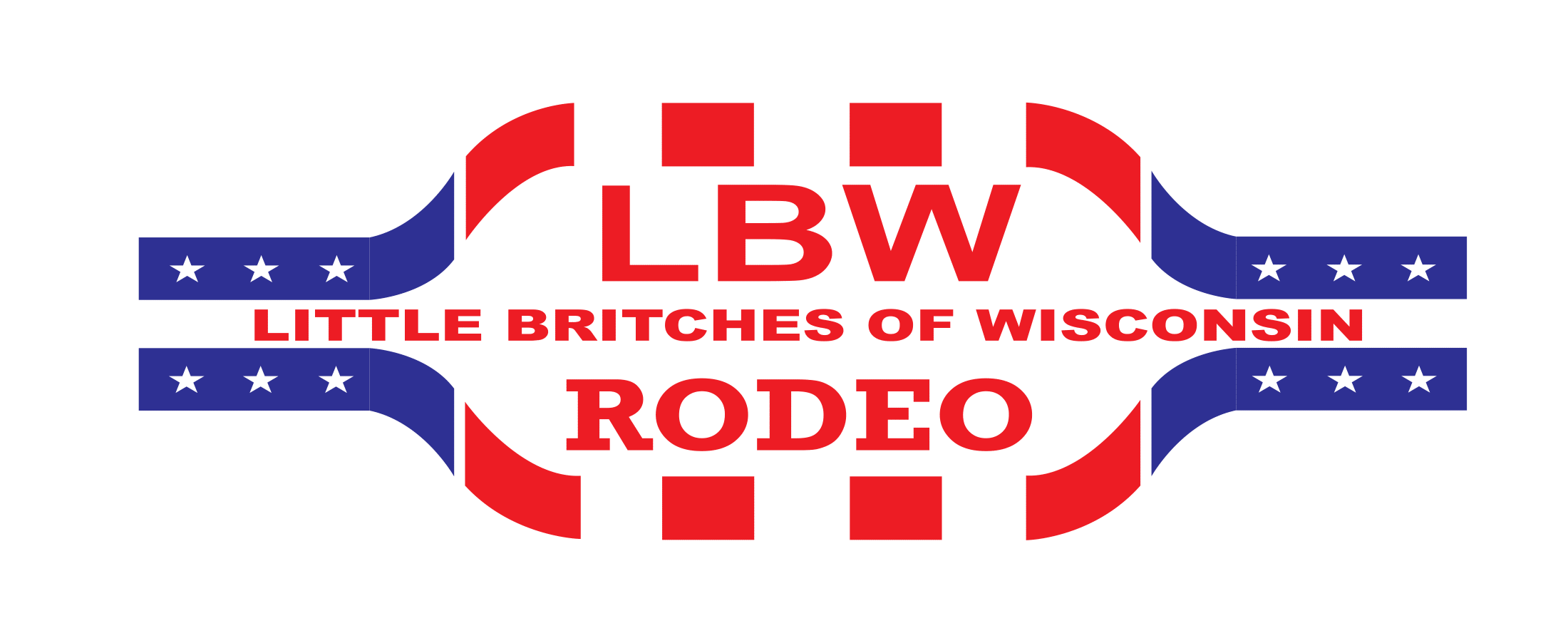Welcome to Little Britches Rodeo of Wisconsin!

LBW includes 3 different divisions. The Peewee division includes children ages 5 years old – 4th grade, and the events include barrels, poles (using 4 poles), goat un-decorating, bulls and bareback riding. The Junior division, ages 5th grade – 8th grade, and the Senior division, 9th grade – 12th grade, both include barrels, poles, goat tying, and breakaway, tie-down, and team roping. These divisions also include the rough stock events of bareback, saddle bronc, and bull riding.
Rodeo 101
Girls Events: Barrel Racing, Pole Bending, Goat Tying, Breakaway Roping, and Team Roping.
Pee Wee Events: Barrel Racing, Pole Bending, Goat Un-decorating, Breakaway, Team Roping, Bareback, and Bull Riding.
Boys Events: Bareback, Saddle Bronc, Bull Riding, Breakaway, Chute Dogging, Tie Down Roping, Bull Riding, Steer Wresting, and Team Roping.
Contestant must run barrels on horseback in cloverleaf pattern, starting at either side. A five-second penalty for each barrel knocked down will be assessed.
Pole bending pattern is to be run around six poles positioned in a straight line. Starting either to the right or left of the first pole, rider runs course patter. Five-second fine for each pole knocked over.
There will be a thirty (30) second time limit for Seniors and forty-five (45) second time limit for Open. Rider, starting when the barrier drops, rides after the calf, throwing loop over its head. As rider pulls up her horse, the running calf breaks the string and the rope falls free from the saddle horn. Time is called when judge drops his flag. Ropes must be released from contestant’s hand to be a legal catch. Horse must clear box before loop is thrown. A ten-second fine for broken barrier will be assessed.
Contestant must string front leg first and then cross and tie any three legs with a piggin’ string. There must be at least one wrap around all three legs and finished with a half hitch or hooey. A hooey is a half hitch with a loop, the tail of the string may be partly or all the way pulled through.
Team may be composed of two boys, two girls, or a boy and girl. In dally team roping, ropes are loose from the saddle horns, and after making the catch, the ropers must take a wrap around the horn. Time is taken when both ropes are tight and both horses are facing the steer. There are strict rules defining a fair head catch. The rope must be around both horns, the neck, half a head. There is a five second fine for a head catch that also catches a front foot or for catching only one hind foot. There is a ten-second penalty for breaking the barrier. There will be a sixty (60) second time limit.
Contestant will run in and dismount. They will pull off the ribbon from the goat’s tail and then run on foot back to the time line.
Horses are scored for high kicking action, power – how hard they kick, lunge, and hit the ground – changing direction, and rolling and twisting. Judges stand on either side of the chute, and the first thing they look for is whether the rider’s feet are over the point of the horse’s shoulders when the animal’s front feet hit the ground on the first jump out of the chute. Each judge will mark one side, using a span of 1 to 25 points each for horse and rider. The four marks will be totaled for the score: 100 points would be the perfect bareback ride. Horses will be ridden eight seconds. Rider cannot touch horse with free hand.
The saddle bronc, like the bareback horse, is rated on how high he kicks, the strength and force of his bucking action, his reverses in direction, and for rolling and twisting action. For the control looked for by the judges, the saddle bronc rider’s spurring action must be exquisitely timed to the horse’s bucking rhythm. The more the rider turns out his toes, the more his spurs will drag in contact with the horse. Length of stroke from neck rearward to the back of the saddle also increases the rider’s score. Riding rein and hand must be on same side. To qualify, rider must have spurs over the break of the shoulders and touching horse when horse’s front feet hit the ground first jump out of the chute. Ride to be eight seconds. Rider will be disqualified for being bucked off; changing hands on rein; losing stirrup; or touching the animal, saddle or rein with free hand.
Riding to be done with one hand and loose rope, with bell attached. Bull to be ridden eight seconds. Rider will be disqualified for being bucked off or touching animal with free hand. A resined soft leather glove is worn on the hand the rider uses to grasp the bull rope. Only the squeeze of his hand on the handhold and the wrap of the rope’s tail hold him to the bull rope. The bull rider’s chaps, perhaps more than in any other event, afford protection against scrapes, stomps and bruises. His dull roweled spurs complete his equipment list. Each of the two judges scores a bull from 1 to 25 on how hard he bucks and kicks, whether he spins, and if he rolls and twists and changes directions during the ride.
The mounted steer wrestler is placed in a box behind a barrier; his hazer in a box on the opposite side of the steer. The steer must be given a head start. The contestant and his hazer overtake the steer at speeds up to 30 miles per hour. He starts to leave the saddle as his horse reaches the steer’s tail. The hazer is allowed only to keep the steer running in a straight line. As the steer wrestler drops over the steer, the horse carries him up to the steer’s head. He scoops the right horn in the crook of his right arm, and grasps the left horn in his left hand and lays the steer on it’s side with all four legs out.
With steers loaded in bucking chute, dogger gets beside the steer, right hand in front of or behind right front shoulder. When dogger calls for the steer the chute gate will be opened. Dogger must keep right hand in front of or behind shoulder until the steer’s nose crosses the score line. If dogger moves into throwing position or touches either horn before steer’s nose crosses score line there will be a ten(10) second penalty added to time. If steer is thrown before crossing the score line the dogger will be disqualified.
If cowboy intends to use two loops, two ropes must be carried. Catch as catch can. Cowboy must dismount, go down rope, throw calf by hand, and cross and tie any three feet. If calf is down when roper reaches it, he must allow calf to get up and then throw him. If roper’s hand is on calf when calf falls, calf is considered thrown by hand. Tie must hold for six seconds after roper calls for time, and slacks rope. There will be a ten-second fine for breaking the barrier.
Frequently Asked Questions
Boys and girls between the ages of six and eighteen or currently enrolled in elementary, middle or high school. In addition to Little Britches Rodeo there is also a very active High School Rodeo Association in our state.
Each spring we hold a clinic. At the clinic we may cover bareback, bull riding, saddle broncs, barrel racing, pole bending, roping and goat tying. These clinics are a great way to find out how to compete and about necessary equipment for the events. Contact secretary@lbwrodeo.com for more information.
Believe it or not, NO!! Horses are provided for the cowboys in the saddle bronc and bareback events and bulls are provided for bull riding events. Girls and boys do need the use of a horse to compete in timed events. These include barrels, pole bending, roping, steer wrestling and goat tying. Two persons may share a horse in some events.
Please come to one of our monthly meetings or better yet come to one of our rodoes or spring clinics and see for yourself what we’re all about. You’re always welcome to contact any of our board members to ask questions. secretary@lbwrodeo.com.
LBW is a family activity that allows elementary and high school aged students to become involved in rodeo competition as well as having a chance to make new friends while having great fun!!!
This years rodeos are listed under Rodeos on the website. There could be more from one year to the next. E-mail questions, comments, or concerns, to secretary@lbwrodeo.com:
JUDGES, ANNOUNCERS, STOCK HANDLERS, AND CHUTE HELP ARE ALL VOLUNTEER POSITIONS.

